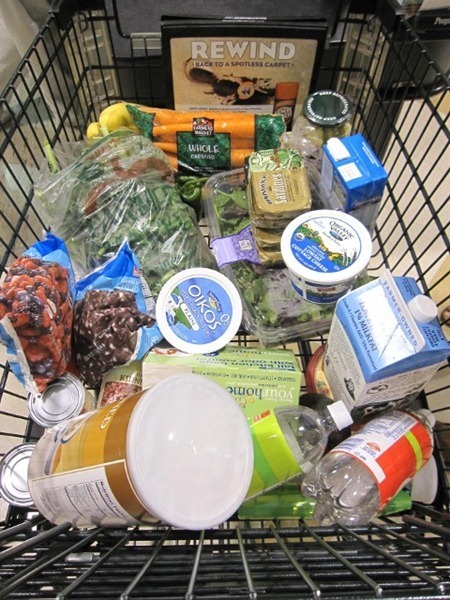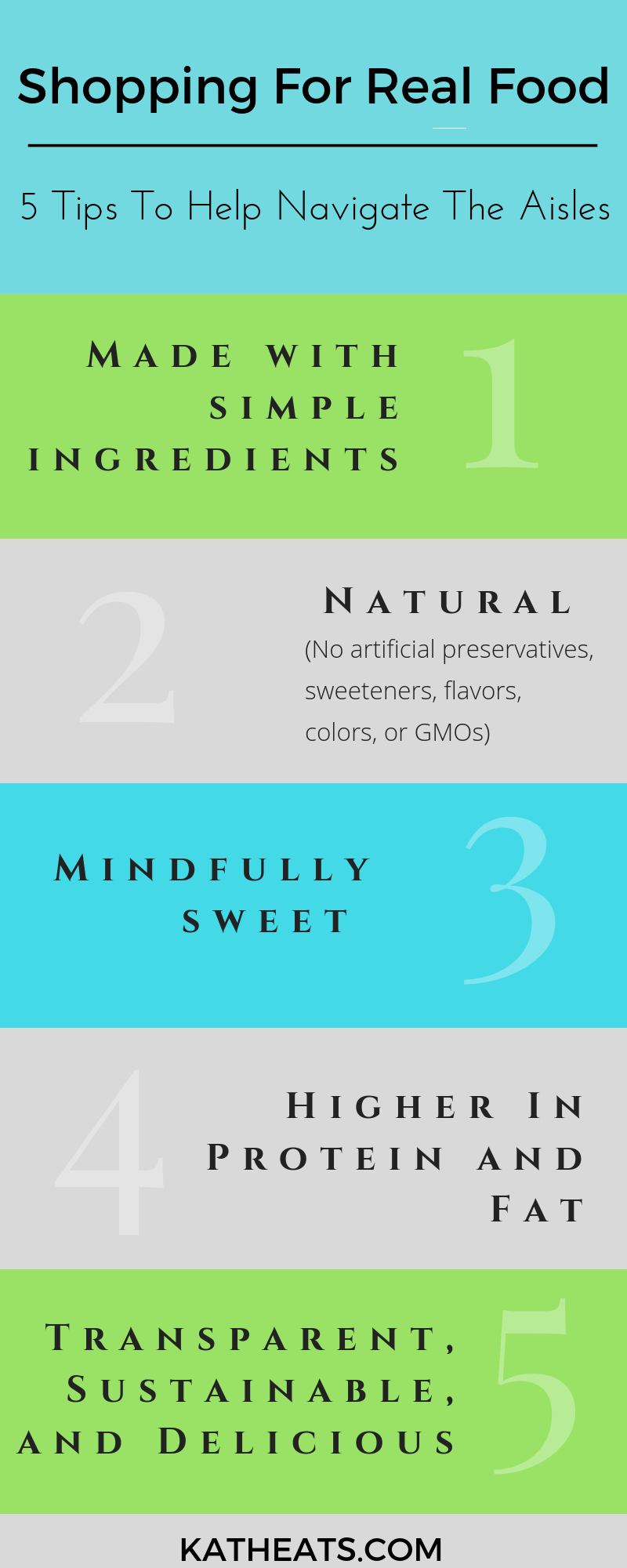Shopping for real food can be confusing. How can you shop for real food but use the convenience of a grocery store too?
Fresh food is best – we can all agree on that.
The ingredient list on an apple says “Contains: apple.” Simple, easy, natural. In fact, no ingredient list is even required. Whole foods should always been the foundation of our diet.
But we also live in a world of convenience, and not everyone has the time or equipment to turn whole ingredients into delicious, on-the-go meals and snacks. Thus, we rely on companies to do some of the heavy lifting for us.
Going to the grocery store and shopping for real food can be quite the overwhelming experience. Sometimes even the simple ingredients can look foreign and ingredients that might be not-so-simple look natural. My best advice is to read the ingredient list to see if the item you’re drooling on has simple ingredients that you recognize. (Check out my Real Food Series for more info!)
If you do get overwhelmed though, rest assured that it’s totally fine and healthy to consume products that are not 100% “clean eating” on occasion. That’s part of being a human and enjoying life. I have myself a diet soda from time to time and enjoy Oreos, Starburst, or Cheese-its on occasion. What is most important is to make the everyday staples you rely on for the bulk of your meals and the foundation of your diet as natural as possible.
Here are five food tips to guide you through shopping for real food:
1. Simple Ingredients
When I’m shopping for anything other than whole foods, I look at the ingredient list first. I need the product to read as a pure, real food. {See my Real Food Series for more in-depth information!} Are the ingredients simple and recognizable? Could I make this at home if I wanted to, even if it would take a long time? If so, I’ll happily let the pros do the cooking/mixing/fermenting/baking for me.
2. Natural (No artificial preservatives, sweeteners, flavors, colors, or GMOs)
I think it’s best to err on the side of caution and stay away from anything made in a laboratory or modified genetically. I also don’t want a product to try and fool me with artificial sweeteners, or to be dyed neon colors (and neither does Mazen!). We like to keep things all-natural; it just tastes better that way! But as I said above, we do eat all of the above from time to time – just not on a daily basis.
3. Mindfully Sweet
Great food choices don’t have be completely sugar-free. When I shop, I want to see that the sugar content in a product is mindful and reasonable. I actually prefer my foods, like yogurt or teas, not very sweet. I like the food’s flavors do all the talking, which gives me the option to add some naturally sweet fruit or crunchy granola on top if I want. Plus if you’re buying plain foods like milk or yogurt, you can make both sweet and savory dishes with them, so you stretch your purchase further than if you buy pre-packaged, flavored yogurts, for example.
4. Higher In Protein and Fat
Protein and fat are important for satiety, so foods that have more than, say 1 gram, on the nutrition facts are going to be more filling than carbohydrate-heavy foods. After looking at the ingredient list, I’ll skim the protein and fat to see how the nutrition breaks down. For example, whole grain crackers verses white flour or chips made from peas or lentils instead of air.
5. Transparent, Sustainable, and Delicious
I believe we vote with our dollars, so I choose to support companies that are doing things the right way, which to me means creating reasonably-priced products that taste great, and doing so in an honest way. You don’t always know what you’re getting, but the more familiar with are with brands (like through blog post collaborations!), the more we can make good choices.
I also appreciate brands that source from farms that raise their animals humanely. While not every brand I buy is 100% local/humane, whenever I’m faced with a choice, I try to choose the one that is, even if it’s more expensive. I respect brands that embrace sustainability. A good example is store-brand tuna fish verses a brand like Wild Planet. Sometimes I buy store-brand by default depending on what’s available, but if I have a choice in the purchase, I’ll reach for the sustainable choice.
More Real Food:
- What Is Real Food?
- The Synergy of Real Food
- How Do You Eat Real Food?
- 10 Ways To Eat More Real Food
- Real Food Kid Meals




Charmaine Ng | Architecture & Lifestyle Blog says
Great tips! I always try to stick by whole foods. It’s the only thing I keep in mind. 🙂
Charmaine Ng | Architecture & Lifestyle Blog
http://charmainenyw.com
Christin Slyngman says
Great advice! I like how reasonable your attitude towards food is…you don’t try to promote a specific “diet” which I truly appreciate. 🙂
Mary says
Thanks for these tips. I often get confused when navigating the “middle aisles” of the market.
Gracie says
Hello
I wanted to thank you for your very informative website about healthy eating.
At 65 years old, it feels like it’s time to get healthy. I should have done this years and years ago.
Your website will help to know what is good food and what is not.
Many thanks and take good care, Gracie